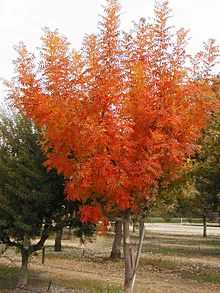Pistacia chinensis
| Chinese pistache | |
|---|---|
 | |
| Pistacia chinensis with autumn colour | |
| Conservation status | |
| Not evaluated (IUCN 2.3) | |
| Scientific classification | |
| Kingdom: | Plantae |
| (unranked): | Angiosperms |
| (unranked): | Eudicots |
| (unranked): | Rosids |
| Order: | Sapindales |
| Family: | Anacardiaceae |
| Genus: | Pistacia |
| Species: | P. chinensis |
| Binomial name | |
| Pistacia chinensis Bunge | |
Pistacia chinensis (English: Chinese pistache; Chinese: 黄连木; pinyin: huángliánmù) is a small to medium-sized tree in the genus Pistacia in the cashew family, Anacardiaceae, native to central and western China. It is hardy, can withstand harsh conditions and poor quality soils, and grows up to 20 m.[1] The leaves are deciduous, alternate, pinnate, 20-25 cm long, with 10 or 12 leaflets, the terminal leaflet usually absent. The flowers are produced in panicles 15-20 cm long at the ends of the branches; it is dioecious, with separate male and female plants. The fruit is a small red drupe, turning blue when ripe, containing a single seed. This species is planted as a street tree in temperate areas worldwide due to its attractive fruit and autumn foliage.
Taxonomy
Synonyms include: Pistacia formosana Matsumura; P. philippinensis Merrill & Rolfe; Rhus argyi H. Léveillé; R. gummifera H. Léveillé.[1]
Some botanists merge Pistacia integerrima into this species as the subspecies P. chinensis ssp. integerrima, with the plants considered here then becoming the subspecies P. chinensis ssp. chinensis.
Distribution and habitat
Its native range is on hill and mountain forests on rocky soils at 100-3600 m above sea level. It is found in China (except in the north) and Taiwan.[1]
Ecology
Chinese pistache grows best in full sun, being intolerant of shade; it is the most frost-tolerant species of Pistacia, tolerating temperatures down to about -25°C, yet it is most highly regarded in warm climates. It is planted for its impressive fall colors, which develop at least as far south as Orlando, Florida. In the low-elevation deserts of Arizona, it is the only tree whose leaves turn scarlet in fall.
Uses
Horticulturally, it is a popular choice for street trees in urban settings because it is very drought tolerant and can survive harsh environments. It is also used as an understock for Pistacia vera.[2] In China, the oil from the seeds is used for biodiesel production. The wood is used for production of furniture and yields a yellow dye.[1]
Culture
It is used in classical Chinese garden design.
References
| Wikispecies has information related to: Pistacia chinensis |
| Wikimedia Commons has media related to Pistacia chinensis. |
- ↑ 1.0 1.1 1.2 1.3 Tianlu Min & Anders Barfod. "Pistacia chinensis Bunge, Enum. Pl. China Bor. 15. 1833". Flora of China. Missouri Botanical Garden, St. Louis, MO & Harvard University Herbaria, Cambridge, MA. Retrieved 14 September 2012.}
- ↑ Ketzel Levine (2003). "Talking Plants: Pistacia_chinensis". NPR. Retrieved 2009-11-11.
Further reading
- Ernest Henry Wilson (1913). A Naturalist in Western China. vol II. London: Methuen & GO. Ltd. OCLC 459058573. Retrieved 2009-11-11.